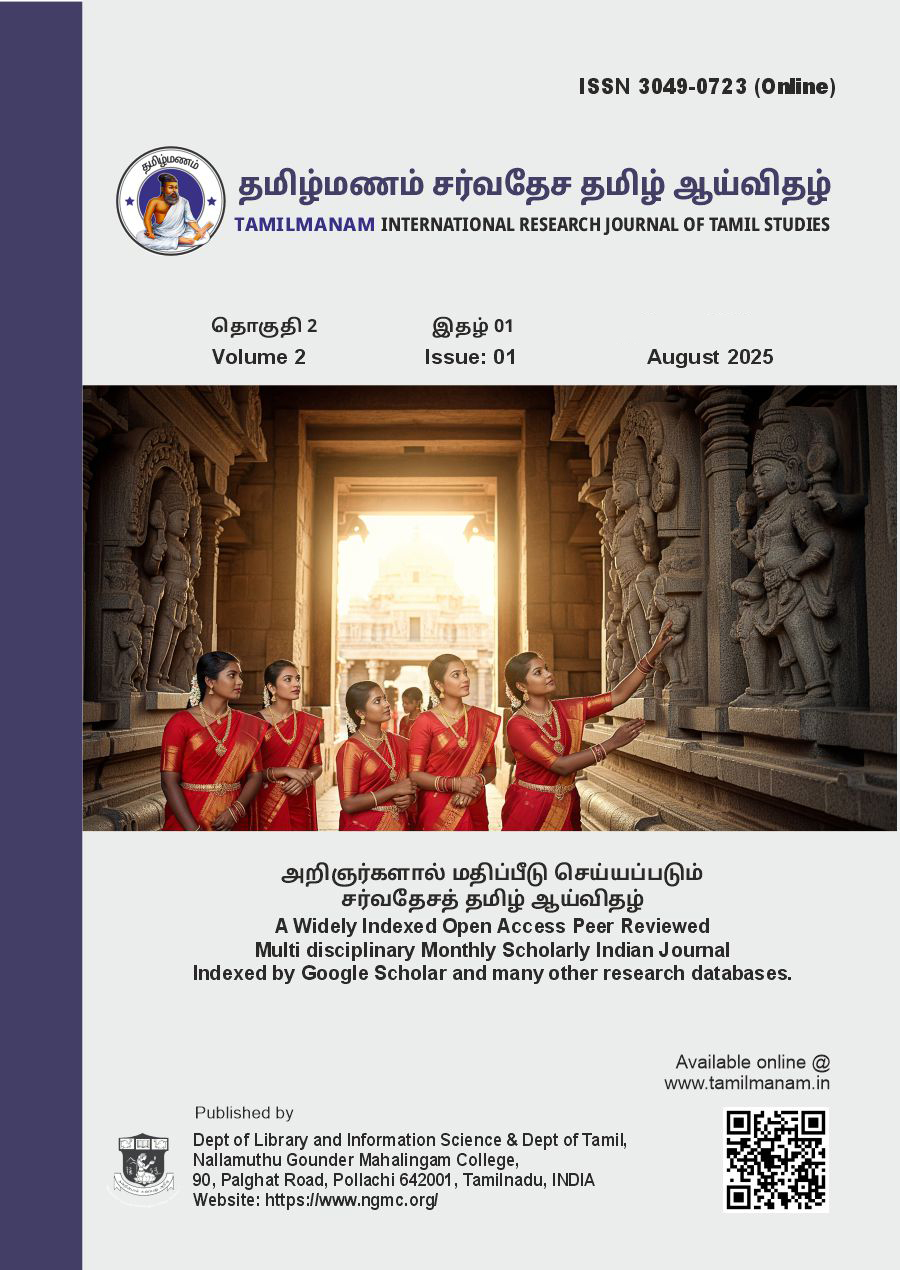தமிழ்த் திரைப்படங்களின் இளைஞர்களின் மதிப்பீடுகள் மற்றும் சமூகப் பழக்கவழக்கங்களில் ஏற்படுத்தும் பாதிப்பு
The Impact of Tamil Films on Youth Values and Social Habits
DOI:
https://doi.org/10.63300/tm0110012517Keywords:
Tamil films, youth, values, social habits, media impact, cultural changeAbstract
This research paper carefully examines the impact of Tamil films on the values and social habits of youth. Films serve not merely as entertainment, but also as a significant medium for cultural transmission. Particularly, Tamil cinema, through its narratives, character development, and social messages, influences the thoughts, beliefs, and lifestyles of young people.
As youth (aged 15–29) represent an age group highly susceptible to social changes, the influence of films is strongly imprinted upon them. The behavior of heroes, dialogue styles, costume choices, and social commentary are directly reflected in the daily lives of young people. Through films, new words, slang, and novel expressions permeate language usage. These spread rapidly via social media and interactions within fan communities.
Some films highlight significant issues such as social justice, gender equality, caste relations, and environmental awareness, thereby encouraging youth to engage in discussions and social activities. Conversely, certain films depicting violence, sexual violence, or extreme patriarchal scenes could also incite negative behaviors.
As indicated by the literature review, media literacy is essential to balance media influences. Media literacy cultivates in youth the ability to critically engage with on-screen content, enabling them to form values consciously and responsibly.
The proposed pilot design for this study will employ a mixed-methods approach, collecting data from 300 young individuals from Chennai and other cities through questionnaires and focus group discussions. Statistical and thematic analyses will be used to assess the positive and negative effects of films on values and habits.
This study proposes recommendations such as the integration of media literacy into educational curricula, filmmakers creating content with social responsibility, and fan communities fostering healthy discussions. In conclusion, it emphasizes that Tamil films serve as a powerful social tool capable of shaping the thoughts and behavior of youth, and that responsible practices in their use are imperative.
இந்த ஆய்வுக் கட்டுரை தமிழ்த் திரைப்படங்கள் இளைஞர்களின் மதிப்பீடுகள் மற்றும் சமூகப் பழக்கவழக்கங்களில் ஏற்படுத்தும் தாக்கத்தைக் கவனமாக ஆராய்கிறது. திரைப்படங்கள் வெறும் பொழுதுபோக்காக மட்டுமல்லாமல், கலாச்சார பரிமாற்றத்தின் முக்கிய ஊடகமாகவும் செயல்படுகின்றன. குறிப்பாக தமிழ் சினிமா, அதன் கதைப்போக்குகள், பாத்திர உருவாக்கம் மற்றும் சமூக செய்திகளின் வழியாக இளைஞர்களின் சிந்தனை, நம்பிக்கைகள் மற்றும் வாழ்க்கை நடைமுறைகளை பாதிக்கிறது.
இளைஞர்கள் (15–29 வயது) சமூக மாற்றங்களை விரைவாகப் பெறும் வயது குழுவாக இருப்பதால், திரைப்படங்களின் தாக்கம் அவர்களிடம் வலுவாகப் பதிவாகிறது. ஹீரோக்களின் நடத்தை, உரையாடல் பாணி, உடைத் தேர்வு, மற்றும் சமூகக் கருத்துக்கள் போன்றவை நேரடியாக இளைஞர்களின் வாழ்வியலில் பிரதிபலிக்கின்றன. திரைப்படங்களின் வழியாக மொழிப் பயன்பாட்டில் புதுமையான சொற்கள், ஸ்லாங், மற்றும் புதிய வெளிப்பாடுகள் பரவுகின்றன. இவை சமூக ஊடகங்களின் மூலமும் ரசிகர் குழுக்களின் தொடர்புகளின் மூலமும் விரைவாக பரவுகின்றன.
சில படங்கள் சமூக நீதி, பாலின சமநிலை, சாதி உறவுகள், சுற்றுச்சூழல் விழிப்புணர்வு போன்ற முக்கிய பிரச்சினைகளை வெளிப்படுத்தி, இளைஞர்களை விவாதங்களிலும் சமூக நடவடிக்கைகளிலும் ஈடுபடச் செய்கின்றன. அதேசமயம், வன்முறை, பாலியல் வன்முறை அல்லது தீவிர ஆணாதிக்கக் காட்சிகளைச் சித்தரிக்கும் சில படங்கள் எதிர்மறையான பழக்கவழக்கங்களையும் தூண்டக்கூடும்.
இலக்கிய மதிப்பாய்வு காட்டியது போல, ஊடகத் தாக்கங்களை சமநிலைப்படுத்த ஊடகக் கல்வி அவசியமாகிறது. ஊடகக் கல்வி இளைஞர்களுக்கு திரையில் காணப்படும் உள்ளடக்கங்களை விமர்சன ரீதியாக அணுகும் திறனை வளர்க்கிறது. இதன் மூலம் அவர்கள் சுயநினைவு மற்றும் பொறுப்புடன் மதிப்பீடுகளை உருவாக்க முடியும்.
ஆய்வில் முன்மொழியப்பட்ட பைலட் வடிவமைப்பு, கலவை முறையை (mixed-methods) பயன்படுத்தி, சென்னை மற்றும் பிற நகரங்களில் இருந்து 300 இளைஞர்களைச் சேர்த்து, கேள்விப்பத்திரம் மற்றும் குழு விவாதங்கள் மூலம் தரவுகளை சேகரிக்கும். புள்ளியியல் மற்றும் கருப்பொருள் பகுப்பாய்வுகள் மூலம், திரைப்படங்கள் மதிப்பீடுகள் மற்றும் பழக்கவழக்கங்களில் ஏற்படுத்தும் நேர்மறை மற்றும் எதிர்மறை விளைவுகள் மதிப்பிடப்படும்.
இந்த ஆய்வு, கல்வி நிறுவனங்களுக்கு ஊடகக் கல்வியை பாடத்திட்டத்தில் இணைப்பது, திரைப்பட தயாரிப்பாளர்கள் சமூகப் பொறுப்புடன் உள்ளடக்கம் உருவாக்குவது, மற்றும் ரசிகர் சமூகங்கள் ஆரோக்கியமான விவாதங்களை ஊக்குவிப்பது ஆகிய பரிந்துரைகளை முன்வைக்கிறது. முடிவில், தமிழ்த் திரைப்படங்கள் இளைஞர்களின் சிந்தனை மற்றும் நடத்தை வடிவமைக்கும் வல்லமையுடைய சமூகக் கருவியாக விளங்குகின்றன என்பதையும், அதை பொறுப்புடன் பயன்படுத்தும் நடைமுறைகள் அவசியம் என்பதையும் வலியுறுத்துகிறது.
Downloads
References
1. Bandura, A. (2001). Social cognitive theory of mass communication. Media Psychology, 3(3), 265–299. https://doi.org/10.1207/S1532785XMEP0303_03
2. Dissanayake, W., & Gokulsing, K. M. (2004). Indian popular cinema: A narrative of cultural change. Trentham Books.
3. Gerbner, G., Gross, L., Morgan, M., & Signorielli, N. (2002). Growing up with television: Cultivation processes. In J. Bryant & D. Zillmann (Eds.), Media effects: Advances in theory and research (pp. 43–67). Lawrence Erlbaum Associates.
4. Rajadhyaksha, A., & Willemen, P. (1999). Encyclopedia of Indian cinema. British Film Institute.
5. Srinivas, S. V. (2009). Megastar: Chiranjeevi and Telugu cinema after N. T. Rama Rao. Oxford University Press.
Downloads
Published
Issue
Section
License
Copyright (c) 2025 பிரியா பழனிமுருகன், முனைவர் வி. சாந்தி (Author)

This work is licensed under a Creative Commons Attribution 4.0 International License.
Our journal adopts CC BY License Creative Commons Attribution 4.0 International License http://Creativecommons.org//license/by/4.0/ . It allows using, reusing, distributing and reproducing of the original work with proper citation.






